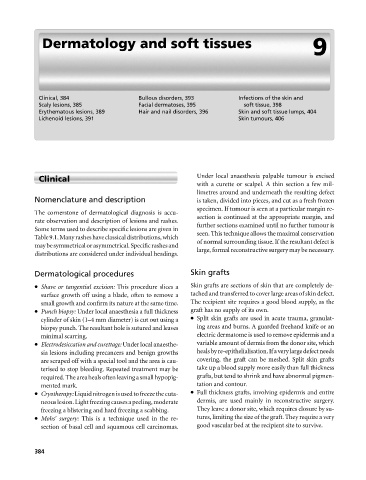Page 388 - Medicine and Surgery
P. 388
P1: FAW
BLUK007-09 BLUK007-Kendall May 12, 2005 19:59 Char Count= 0
Dermatology and soft tissues 9
Clinical, 384 Bullous disorders, 393 Infections of the skin and
Scaly lesions, 385 Facial dermatoses, 395 soft tissue, 398
Erythematous lesions, 389 Hair and nail disorders, 396 Skin and soft tissue lumps, 404
Lichenoid lesions, 391 Skin tumours, 406
Under local anaesthesia palpable tumour is excised
Clinical
with a curette or scalpel. A thin section a few mil-
limetres around and underneath the resulting defect
Nomenclature and description is taken, divided into pieces, and cut as a fresh frozen
specimen. If tumour is seen at a particular margin re-
The cornerstone of dermatological diagnosis is accu-
section is continued at the appropriate margin, and
rate observation and description of lesions and rashes.
further sections examined until no further tumour is
Some terms used to describe specific lesions are given in
seen. This technique allows the maximal conservation
Table9.1.Manyrasheshaveclassicaldistributions,which
of normal surrounding tissue. If the resultant defect is
maybesymmetricalorasymmetrical.Specificrashesand
large, formal reconstructive surgery may be necessary.
distributions are considered under individual headings.
Dermatological procedures Skin grafts
Shaveor tangential excision: This procedure slices a
Skin grafts are sections of skin that are completely de-
surface growth off using a blade, often to remove a tached and transferred to cover large areas of skin defect.
small growth and confirm its nature at the same time. The recipient site requires a good blood supply, as the
Punch biopsy: Under local anaesthesia a full thickness
graft has no supply of its own.
cylinder of skin (1–4 mm diameter) is cut out using a Split skin grafts are used in acute trauma, granulat-
biopsy punch. The resultant hole is sutured and leaves ing areas and burns. A guarded freehand knife or an
minimal scarring. electric dermatome is used to remove epidermis and a
Electrodesiccation and curettage: Under local anaesthe-
variable amount of dermis from the donor site, which
sia lesions including precancers and benign growths healsbyre-epithelialisation.Ifaverylargedefectneeds
are scraped off with a special tool and the area is cau- covering, the graft can be meshed. Split skin grafts
terised to stop bleeding. Repeated treatment may be take up a blood supply more easily than full thickness
required. The area heals often leaving a small hypopig- grafts, but tend to shrink and have abnormal pigmen-
mented mark. tation and contour.
Cryotherapy:Liquidnitrogenisusedtofreezethecuta-
Full thickness grafts, involving epidermis and entire
neouslesion.Lightfreezingcausesapeeling,moderate dermis, are used mainly in reconstructive surgery.
freezing a blistering and hard freezing a scabbing. They leave a donor site, which requires closure by su-
Mohs’ surgery: This is a technique used in the re-
tures, limiting the size of the graft. They require a very
section of basal cell and squamous cell carcinomas. good vascular bed at the recipient site to survive.
384

